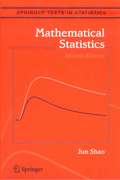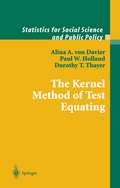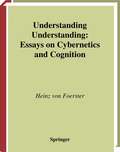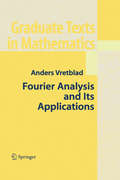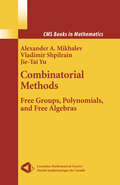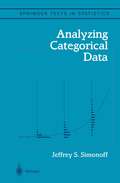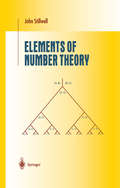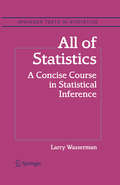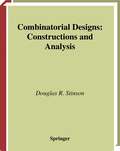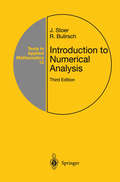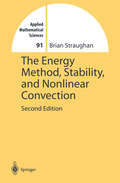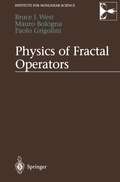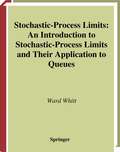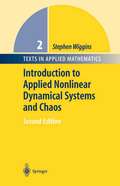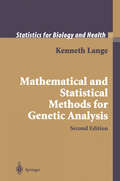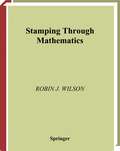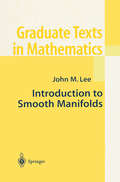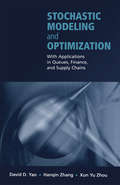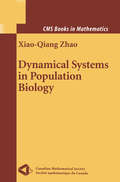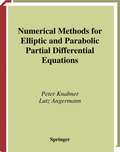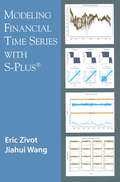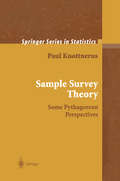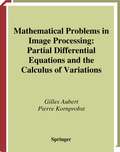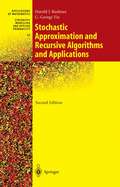- Table View
- List View
Mathematical Statistics (Springer Texts in Statistics)
by Jun ShaoThis graduate textbook covers topics in statistical theory essential for graduate students preparing for work on a Ph.D. degree in statistics. This new edition has been revised and updated and in this fourth printing, errors have been ironed out. The first chapter provides a quick overview of concepts and results in measure-theoretic probability theory that are useful in statistics. The second chapter introduces some fundamental concepts in statistical decision theory and inference. Subsequent chapters contain detailed studies on some important topics: unbiased estimation, parametric estimation, nonparametric estimation, hypothesis testing, and confidence sets. A large number of exercises in each chapter provide not only practice problems for students, but also many additional results.
The Kernel Method of Test Equating (Statistics for Social and Behavioral Sciences)
by Alina A. Davier Paul W. Holland Dorothy T. ThayerKE is applied to the four major equating designs and to both Chain Equating and Post-Stratification Equating for the Non-Equivalent groups with Anchor Test Design. It will be an important reference for several groups: (a) Statisticians (b) Practitioners and (c) Instructors in psychometric and measurement programs. The authors assume some familiarity with linear and equipercentile test equating, and with matrix algebra.
Understanding Understanding: Essays on Cybernetics and Cognition
by Heinz von FoersterIn these ground-breaking essays, Heinz von Foerster discusses some of the fundamental principles that govern how we know the world and how we process the information from which we derive that knowledge. The author was one of the founders of the science of cybernetics.
Fourier Analysis and Its Applications (Graduate Texts in Mathematics #223)
by Anders VretbladA carefully prepared account of the basic ideas in Fourier analysis and its applications to the study of partial differential equations. The author succeeds to make his exposition accessible to readers with a limited background, for example, those not acquainted with the Lebesgue integral. Readers should be familiar with calculus, linear algebra, and complex numbers. At the same time, the author has managed to include discussions of more advanced topics such as the Gibbs phenomenon, distributions, Sturm-Liouville theory, Cesaro summability and multi-dimensional Fourier analysis, topics which one usually does not find in books at this level. A variety of worked examples and exercises will help the readers to apply their newly acquired knowledge.
Combinatorial Methods: Free Groups, Polynomials, and Free Algebras (CMS Books in Mathematics)
by Vladimir Shpilrain Alexander Mikhalev Jie-tai YuThe main purpose of this book is to show how ideas from combinatorial group theory have spread to two other areas of mathematics: the theory of Lie algebras and affine algebraic geometry. Some of these ideas, in turn, came to combinatorial group theory from low-dimensional topology in the beginning of the 20th Century.
Analyzing Categorical Data (Springer Texts in Statistics)
by Jeffrey S. SimonoffCategorical data arise often in many fields, including biometrics, economics, management, manufacturing, marketing, psychology, and sociology. This book provides an introduction to the analysis of such data. The coverage is broad, using the loglinear Poisson regression model and logistic binomial regression models as the primary engines for methodology. Topics covered include count regression models, such as Poisson, negative binomial, zero-inflated, and zero-truncated models; loglinear models for two-dimensional and multidimensional contingency tables, including for square tables and tables with ordered categories; and regression models for two-category (binary) and multiple-category target variables, such as logistic and proportional odds models. All methods are illustrated with analyses of real data examples, many from recent subject area journal articles. These analyses are highlighted in the text, and are more detailed than is typical, providing discussion of the context and background of the problem, model checking, and scientific implications. More than 200 exercises are provided, many also based on recent subject area literature. Data sets and computer code are available at a web site devoted to the text. Adopters of this book may request a solutions manual from: textbook@springer-ny.com. From the reviews: "Jeff Simonoff's book is at the top of the heap of categorical data analysis textbooks...The examples are superb. Student reactions in a class I taught from this text were uniformly positive, particularly because of the examples and exercises. Additional materials related to the book, particularly code for S-Plus, SAS, and R, useful for analysis of examples, can be found at the author's Web site at New York University. I liked this book for this reason, and recommend it to you for pedagogical purposes." (Stanley Wasserman, The American Statistician, August 2006, Vol. 60, No. 3) "The book has various noteworthy features. The examples used are from a variety of topics, including medicine, economics, sports, mining, weather, as well as social aspects like needle-exchange programs. The examples motivate the theory and also illustrate nuances of data analytical procedures. The book also incorporates several newer methods for analyzing categorical data, including zero-inflated Poisson models, robust analysis of binomial and poisson models, sandwich estimators, multinomial smoothing, ordinal agreement tables…this is definitely a good reference book for any researcher working with categorical data." Technometrics, May 2004 "This guide provides a practical approach to the appropriate analysis of categorical data and would be a suitable purchase for individuals with varying levels of statistical understanding." Paediatric and Perinatal Epidemiology, 2004, 18 "This book gives a fresh approach to the topic of categorical data analysis. The presentation of the statistical methods exploits the connection to regression modeling with a focus on practical features rather than formal theory...There is much to learn from this book. Aside from the ordinary materials such as association diagrams, Mantel-Haenszel estimators, or overdispersion, the reader will also find some less-often presented but interesting and stimulating topics...[T]his is an excellent book, giving an up-to-date introduction to the wide field of analyzing categorical data." Biometrics, September 2004 "...It is of great help to data analysts, practitioners and researchers who deal with categorical data and need to get a necessary insight into the methods of analysis as well as practical guidelines for solving problems." International Journal of General Systems, August 2004 "The author has succeeded in writing a useful and readable textbook combining most of general theory and practice of count data." Kwantitatieve Methoden "The book especially stresses how to analyze and interpret data...In fact, the highly detailed mult
Elements of Number Theory (Undergraduate Texts in Mathematics)
by John StillwellSolutions of equations in integers is the central problem of number theory and is the focus of this book. The amount of material is suitable for a one-semester course. The author has tried to avoid the ad hoc proofs in favor of unifying ideas that work in many situations. There are exercises at the end of almost every section, so that each new idea or proof receives immediate reinforcement.
All of Statistics: A Concise Course in Statistical Inference (Springer Texts in Statistics)
by Larry WassermanTaken literally, the title "All of Statistics" is an exaggeration. But in spirit, the title is apt, as the book does cover a much broader range of topics than a typical introductory book on mathematical statistics. This book is for people who want to learn probability and statistics quickly. It is suitable for graduate or advanced undergraduate students in computer science, mathematics, statistics, and related disciplines. The book includes modern topics like non-parametric curve estimation, bootstrapping, and classification, topics that are usually relegated to follow-up courses. The reader is presumed to know calculus and a little linear algebra. No previous knowledge of probability and statistics is required. Statistics, data mining, and machine learning are all concerned with collecting and analysing data.
Combinatorial Designs: Constructions and Analysis
by Douglas StinsonCreated to teach students many of the most important techniques used for constructing combinatorial designs, this is an ideal textbook for advanced undergraduate and graduate courses in combinatorial design theory. The text features clear explanations of basic designs, such as Steiner and Kirkman triple systems, mutual orthogonal Latin squares, finite projective and affine planes, and Steiner quadruple systems. In these settings, the student will master various construction techniques, both classic and modern, and will be well-prepared to construct a vast array of combinatorial designs. Design theory offers a progressive approach to the subject, with carefully ordered results. It begins with simple constructions that gradually increase in complexity. Each design has a construction that contains new ideas or that reinforces and builds upon similar ideas previously introduced. A new text/reference covering all apsects of modern combinatorial design theory. Graduates and professionals in computer science, applied mathematics, combinatorics, and applied statistics will find the book an essential resource.
Introduction to Numerical Analysis (Texts in Applied Mathematics #12)
by J. Stoer R. BulirschNew edition of a well-known classic in the field; Previous edition sold over 6000 copies worldwide; Fully-worked examples; Many carefully selected problems
The Energy Method, Stability, and Nonlinear Convection (Applied Mathematical Sciences #91)
by Brian StraughanSix new chapters (14-19) deal with topics of current interest: multi-component convection diffusion, convection in a compressible fluid, convenction with temperature dependent viscosity and thermal conductivity, penetrative convection, nonlinear stability in ocean circulation models, and numerical solution of eigenvalue problems.
Physics of Fractal Operators (Institute for Nonlinear Science)
by Bruce West Mauro Bologna Paolo GrigoliniThis text describes the statistcal behavior of complex systems and shows how the fractional calculus can be used to model the behavior. The discussion emphasizes physical phenomena whose evolution is best described using the fractional calculus, such as systems with long-range spatial interactions or long-time memory. The book gives general strategies for understanding wave propagation through random media, the nonlinear response of complex materials, and the fluctuations of heat transport in heterogeneous materials.
Stochastic-Process Limits: An Introduction to Stochastic-Process Limits and Their Application to Queues (Springer Series in Operations Research and Financial Engineering)
by Ward WhittFrom the reviews: "The material is self-contained, but it is technical and a solid foundation in probability and queuing theory is beneficial to prospective readers. [… It] is intended to be accessible to those with less background. This book is a must to researchers and graduate students interested in these areas." ISI Short Book Reviews
Introduction to Applied Nonlinear Dynamical Systems and Chaos (Texts in Applied Mathematics #2)
by Stephen WigginsThis introduction to applied nonlinear dynamics and chaos places emphasis on teaching the techniques and ideas that will enable students to take specific dynamical systems and obtain some quantitative information about their behavior. The new edition has been updated and extended throughout, and contains a detailed glossary of terms. From the reviews: "Will serve as one of the most eminent introductions to the geometric theory of dynamical systems." --Monatshefte für Mathematik
Mathematical and Statistical Methods for Genetic Analysis (Statistics for Biology and Health)
by Kenneth LangeWritten to equip students in the mathematical siences to understand and model the epidemiological and experimental data encountered in genetics research. This second edition expands the original edition by over 100 pages and includes new material. Sprinkled throughout the chapters are many new problems.
Stamping through Mathematics
by Robin J. WilsonThe astonishing variety and beauty of mathematical elements in stamp design is brought to life in this collection of more than 350 stamps, illustrated with mathematical figures, people, and content, each reproduced in enlarged format, in full color. It's a perfect gift book for anyone interested in stamps, or in the surprising use of mathematics in the real world. The author is widely known in the math community for his regular column on stamps in the magazine The Mathematical Intelligencer.
Introduction to Smooth Manifolds (Graduate Texts in Mathematics #218)
by John M. LeeAuthor has written several excellent Springer books.; This book is a sequel to Introduction to Topological Manifolds; Careful and illuminating explanations, excellent diagrams and exemplary motivation; Includes short preliminary sections before each section explaining what is ahead and why
Stochastic Modeling and Optimization: With Applications in Queues, Finance, and Supply Chains
by David D. Yao Hanqin Zhang Xun Yu ZhouThis books covers the broad range of research in stochastic models and optimization. Applications presented include networks, financial engineering, production planning, and supply chain management. Each contribution is aimed at graduate students working in operations research, probability, and statistics.
Dynamical Systems in Population Biology (CMS Books in Mathematics)
by Xiao-Qiang ZhaoPopulation dynamics is an important subject in mathematical biology. A cen tral problem is to study the long-term behavior of modeling systems. Most of these systems are governed by various evolutionary equations such as difference, ordinary, functional, and partial differential equations (see, e. g. , [165, 142, 218, 119, 55]). As we know, interactive populations often live in a fluctuating environment. For example, physical environmental conditions such as temperature and humidity and the availability of food, water, and other resources usually vary in time with seasonal or daily variations. Therefore, more realistic models should be nonautonomous systems. In particular, if the data in a model are periodic functions of time with commensurate period, a periodic system arises; if these periodic functions have different (minimal) periods, we get an almost periodic system. The existing reference books, from the dynamical systems point of view, mainly focus on autonomous biological systems. The book of Hess [106J is an excellent reference for periodic parabolic boundary value problems with applications to population dynamics. Since the publication of this book there have been extensive investigations on periodic, asymptotically periodic, almost periodic, and even general nonautonomous biological systems, which in turn have motivated further development of the theory of dynamical systems. In order to explain the dynamical systems approach to periodic population problems, let us consider, as an illustration, two species periodic competitive systems dUI dt = !I(t,Ul,U2), (0.
Numerical Methods for Elliptic and Parabolic Partial Differential Equations (Texts in Applied Mathematics #44)
by Peter Knabner Lutz AngermanThis text provides an application oriented introduction to the numerical methods for partial differential equations. It covers finite difference, finite element, and finite volume methods, interweaving theory and applications throughout. The book examines modern topics such as adaptive methods, multilevel methods, and methods for convection-dominated problems and includes detailed illustrations and extensive exercises.
Sample Survey Theory: Some Pythagorean Perspectives (Springer Series in Statistics)
by Paul KnottnerusThis book describes a novel approach to the theory of sampling from finite populations. The new unifying approach is based on the sampling autocorrelation coefficient. The author derives a general set of sampling equations that describe the estimators, their variances as well as the corresponding variance estimators. This volume will be useful for survey practitioners faced with complex surveys.
Mathematical Problems in Image Processing: Partial Differential Equations and the Calculus of Variations (Applied Mathematical Sciences #147)
by Gilles Aubert Pierre KornprobstPartial differential equations and variational methods were introduced into image processing about 15 years ago, and intensive research has been carried out since then. The main goal of this work is to present the variety of image analysis applications and the precise mathematics involved. It is intended for two audiences. The first is the mathematical community, to show the contribution of mathematics to this domain and to highlight some unresolved theoretical questions. The second is the computer vision community, to present a clear, self-contained, and global overview of the mathematics involved in image processing problems.The book is divided into five main parts. Chapter 1 is a detailed overview. Chapter 2 describes and illustrates most of the mathematical notions found throughout the work. Chapters 3 and 4 examine how PDEs and variational methods can be successfully applied in image restoration and segmentation processes. Chapter 5, which is more applied, describes some challenging computer vision problems, such as sequence analysis or classification. This book will be useful to researchers and graduate students in mathematics and computer vision.
The Theory of Finite Groups: An Introduction (Universitext)
by Hans Kurzweil Bernd StellmacherFrom reviews of the German edition: "This is an exciting text and a refreshing contribution to an area in which challenges continue to flourish and to captivate the viewer. Even though representation theory and constructions of simple groups have been omitted, the text serves as a springboard for deeper study in many directions." Mathematical Reviews
Stochastic Approximation and Recursive Algorithms and Applications (Stochastic Modelling and Applied Probability #35)
by Harold Kushner G. George YinThis book presents a thorough development of the modern theory of stochastic approximation or recursive stochastic algorithms for both constrained and unconstrained problems. This second edition is a thorough revision, although the main features and structure remain unchanged. It contains many additional applications and results as well as more detailed discussion.
